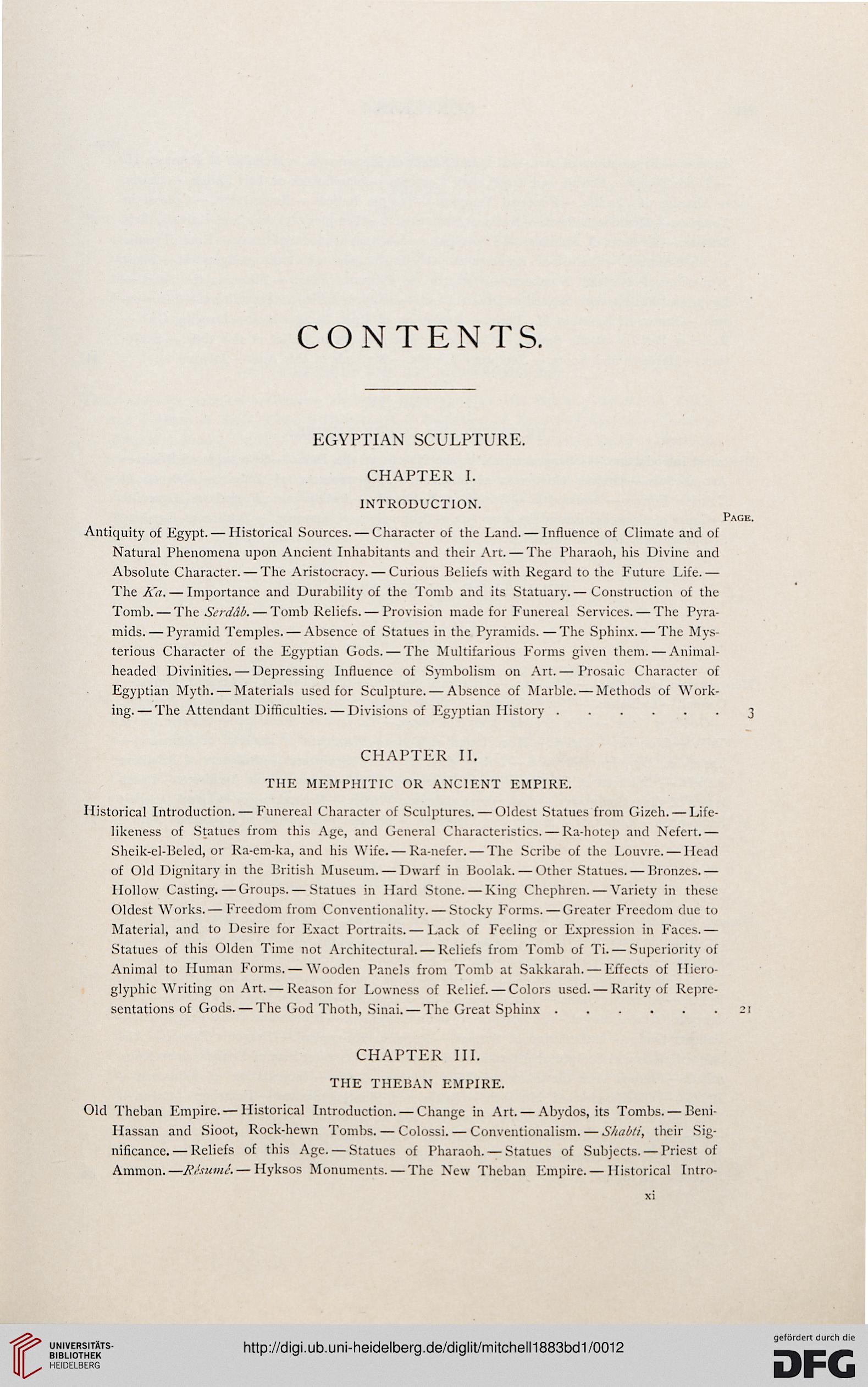CONTENTS.
EGYPTIAN SCULPTURE.
CHAPTER I.
INTRODUCTION.
Page.
Antiquity of Egypt. — Historical Sources. — Character of the Land. — Influence of Climate and of
Natural Phenomena upon Ancient Inhabitants and their Art. — The Pharaoh, his Divine and
Absolute Character. — The Aristocracy. — Curious Beliefs with Regard to the Future Life.—
The A?;. — Importance and Durability of the Tomb and its Statuary.— Construction of the
Tomb. — The Scrdab. — Tomb Reliefs. — Provision made for Funereal Services. — The Pyra-
mids.— Pyramid Temples. — Absence of Statues in the Pyramids. — The Sphinx. — The Mys-
terious Character of the Egyptian Gods. — The Multifarious Forms given them. — Animal-
headed Divinities. — Depressing Influence of Symbolism on Art.— Prosaic Character of
Egyptian Myth. — Materials used for Sculpture. — Absence of Marble. — Methods of Work-
ing.— The Attendant Difficulties. — Divisions of Egyptian History......3
CHAPTER II.
THE MEMPHITIC OR ANCIENT EMPIRE.
Historical Introduction. — Funereal Character of Sculptures. — Oldest Statues from Gizeh. — Life-
likeness of Statues from this Age, and General Characteristics. — Ra-hotep and Nefcrt.—
Sheik-el-licled, or Ra-em-ka, and his Wife. — Ra-nefer. — The Scribe of the Louvre. — Head
of Old Dignitary in the British Museum. — Dwarf in lloolak. — Other Statues. — Bronzes.—
Hollow Casting.—Groups. — Statues in Hard Stone. — King Chcphren. — Variety in these
Oldest Works.— Freedom from Conventionality. — Stocky Forms. — Greater Freedom due to
Material, and to Desire for Exact Portraits. — Lack of Feeling or Expression in Faces.—
Statues of this Olden Time not Architectural. — Reliefs from Tomb of Ti. — Superiority of
Animal to Human Forms. — Wooden Panels from Tomb at Sakkarah. — Effects of Hiero-
glyphic Writing on Art. — Reason for Lowness of Relief. — Colors used. — Rarity of Repre-
sentations of Gods.— The God Thoth, Sinai. — The Great Sphinx......21
CHAPTER III.
THE THEBAN EMPIRE.
Old Theban Empire. — Historical Introduction. — Change in Art. — Abydos, its Tombs. — Beni-
Hassan and Sioot, Rock-hewn Tombs. — Colossi. — Conventionalism. — Sliabti, their Sig-
nificance.— Reliefs of this Age. — Statues of Pharaoh. — Statues of Subjects. — Priest of
Amnion.—Rlsuml. — Hyksos Monuments. — The New Theban Empire. — Historical Intro-
EGYPTIAN SCULPTURE.
CHAPTER I.
INTRODUCTION.
Page.
Antiquity of Egypt. — Historical Sources. — Character of the Land. — Influence of Climate and of
Natural Phenomena upon Ancient Inhabitants and their Art. — The Pharaoh, his Divine and
Absolute Character. — The Aristocracy. — Curious Beliefs with Regard to the Future Life.—
The A?;. — Importance and Durability of the Tomb and its Statuary.— Construction of the
Tomb. — The Scrdab. — Tomb Reliefs. — Provision made for Funereal Services. — The Pyra-
mids.— Pyramid Temples. — Absence of Statues in the Pyramids. — The Sphinx. — The Mys-
terious Character of the Egyptian Gods. — The Multifarious Forms given them. — Animal-
headed Divinities. — Depressing Influence of Symbolism on Art.— Prosaic Character of
Egyptian Myth. — Materials used for Sculpture. — Absence of Marble. — Methods of Work-
ing.— The Attendant Difficulties. — Divisions of Egyptian History......3
CHAPTER II.
THE MEMPHITIC OR ANCIENT EMPIRE.
Historical Introduction. — Funereal Character of Sculptures. — Oldest Statues from Gizeh. — Life-
likeness of Statues from this Age, and General Characteristics. — Ra-hotep and Nefcrt.—
Sheik-el-licled, or Ra-em-ka, and his Wife. — Ra-nefer. — The Scribe of the Louvre. — Head
of Old Dignitary in the British Museum. — Dwarf in lloolak. — Other Statues. — Bronzes.—
Hollow Casting.—Groups. — Statues in Hard Stone. — King Chcphren. — Variety in these
Oldest Works.— Freedom from Conventionality. — Stocky Forms. — Greater Freedom due to
Material, and to Desire for Exact Portraits. — Lack of Feeling or Expression in Faces.—
Statues of this Olden Time not Architectural. — Reliefs from Tomb of Ti. — Superiority of
Animal to Human Forms. — Wooden Panels from Tomb at Sakkarah. — Effects of Hiero-
glyphic Writing on Art. — Reason for Lowness of Relief. — Colors used. — Rarity of Repre-
sentations of Gods.— The God Thoth, Sinai. — The Great Sphinx......21
CHAPTER III.
THE THEBAN EMPIRE.
Old Theban Empire. — Historical Introduction. — Change in Art. — Abydos, its Tombs. — Beni-
Hassan and Sioot, Rock-hewn Tombs. — Colossi. — Conventionalism. — Sliabti, their Sig-
nificance.— Reliefs of this Age. — Statues of Pharaoh. — Statues of Subjects. — Priest of
Amnion.—Rlsuml. — Hyksos Monuments. — The New Theban Empire. — Historical Intro-




